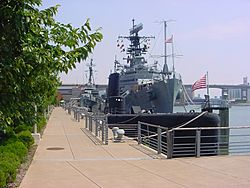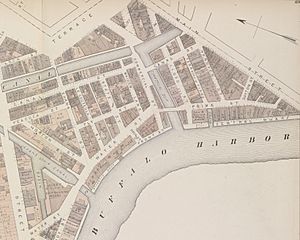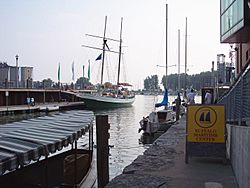Canalside facts for kids
Quick facts for kids
Canalside
Erie Canal Harbor
|
|
|---|---|
|
Neighborhood of Buffalo
|
|

View of Canalside from Central Wharf, looking north
|
|
| Country | |
| State | |
| County | Erie County |
| City | Buffalo |
Canalside, also known as Erie Canal Harbor, is a fun and planned neighborhood in Buffalo, New York. It's located right on the Buffalo River. This area was designed to look like the historic end of the famous Erie Canal. Long ago, the Seneca people lived here.
In the early 1900s, this busy area changed a lot. The old canals were filled in, and many buildings were taken down. New roads like the Buffalo Skyway and Niagara Thruway were built. The Buffalo Memorial Auditorium also took up space here.
After the KeyBank Center opened in 1996, the Memorial Auditorium was empty. In 1999, a plan was made to rebuild the Erie Canal Harbor area. A new plan in 2004 focused on bringing back the historic canals. It also aimed to create new buildings for different uses.
There were some delays and discussions about the project. For example, a large Bass Pro Shops store was planned but later canceled. The Memorial Auditorium was taken down by 2009. The land was then divided into smaller sections, just like it was in the 1800s. Since 2010, Canalside has seen many new buildings and exciting events. Places like LECOM Harborcenter and the Explore & More Children's Museum have opened here.
Contents
Canalside's Early Days
The Erie Canal Harbor was built in Buffalo, New York in 1825. It was called the "portal to the west." For most of the 1800s, it was a major stop for goods and people traveling from the East Coast. They would cross the Great Lakes from here. This busy harbor helped Buffalo grow into a thriving city. The famous Canal Street was very close to the canal's end.
This area was once the site of the first Village of Buffalo. It was near a Seneca village on Buffalo Creek. Over time, the city of Buffalo grew outward from this waterfront spot.
The Erie Canal opened in 1825. It made it much easier for travelers and trade to move between the East Coast and the western United States. This led to a huge increase in ship traffic in Buffalo's harbor. Many canal and ship crew members would get paid in Buffalo. They often spent their money in the district, which had many businesses. The song "Buffalo Gals" was written in 1844 and is about the women who lived in this canal area.
In the early 1900s, the Erie Canal was made deeper and shorter. As canal traffic moved to railroads, Italian immigrants, mostly from Sicily, moved into the district. Canal Street was renamed Dante Place. The neighborhood became known as Dante Place or "Little Italy."
By the late 1920s, New York State filled in the Canal. The still and polluted canal waters were seen as a health risk.
The neighborhood faced many fires and other problems over the years. A big explosion happened on January 1, 1936. This event brought attention to crowded areas. New laws were passed that allowed cities to tear down unsafe buildings. This started the process of urban renewal. By 1937, over 160 buildings in Dante Place were demolished. By 1948, only 90 families remained in the area.
In 1938, there were plans for new housing called "Fairhaven Village." It would have housed 962 families. However, the Great Depression and World War II meant there wasn't enough money to build it. Around the same time, Buffalo officials used funds to build the Buffalo Memorial Auditorium. It was built on the former northeastern part of the neighborhood. The last parts of the old Canal Street/Dante Place neighborhood were torn down in 1950. The "Fairhaven Village" project was later built as the Marine Drive Apartments in 1952. The New York State Thruway and the Skyway were built in 1955.
The Commercial Slip was a small part of Little Buffalo Creek. It flowed into the Buffalo River. The Commercial Slip was a boundary of Buffalo's old Canal District. It was filled in when the area was redeveloped in the 1950s. The New York State Thruway, the Skyway, and the Buffalo Memorial Auditorium were built over the Canal district. The Commercial Slip was buried and forgotten.
Bringing Canalside Back to Life
In the late 1990s, people started to think about bringing back Buffalo's Erie Canal history. At first, plans were just to rebuild some buried parts of the Canal. But many citizens and local media pushed for more. They wanted to dig up and restore actual parts of the district, including the Commercial Slip.
In 2005, $279 million was made available for the project. This money came from a deal to re-license the Niagara Power Project. The deal also created the Erie Canal Harbor Development Corporation. This group manages the money and projects along the waterfront.
The Erie Canal Redevelopment project dug up old building foundations from the Canal era. It also restored the Commercial Slip. This slip was the original natural connection between Little Buffalo Creek and the Buffalo River.
Phase 2 of the inner harbor plan was finished in 2008. It included refilling the Commercial Slip with water so boats could use it. They also built walkways on both sides of the slip. A new truss bridge was built, and Commercial Street was rebuilt. The old Steamboat Hotel and Lloyd Street ruins were uncovered and saved as an archaeological site.
From 2008 to 2009, the old Buffalo Memorial Auditorium was torn down. It was an old and failing building. There were plans to build a Bass Pro store there, but those plans were later canceled.
The first part of the historic canal harbor area opened to the public in 2008. This was the result of almost ten years of hard work. It brought back several unique features of the original Canal district. These included the Commercial Slip, the wooden Central Wharf, and the award-winning Whipple Truss foot bridge. Old canal-era buildings now hold naval and military items. The excavation site of the original Steamship Hotel foundations is also on display.
Building the Canals
The Erie Canal Harbor Development Corporation planned Canalside for seven years. They wanted to create canals that would act like reflecting pools. These canals also have a freezing system. This allows them to be used for ice skating and ice biking in the winter.
The canals were built on the site of the old Memorial Auditorium. They were finished in 2014. They have water in the spring and summer. In winter, they turn into ice rinks for skating.
New Buildings and Businesses
The first big private project at Canalside was the renovation of the Donovan State Office Building. It's now called One Canalside. This project included a hotel, a restaurant, and office spaces. Construction started in 2012 and finished in 2014.
The second major project was the Buffalo Sabres' hockey-themed LECOM Harborcenter. This building was the most expensive privately funded building in Buffalo's history. Construction began in March 2013. The building has two NHL-sized hockey rinks, a parking garage, restaurants, a Marriott hotel, and shops. It was fully completed in 2015.
On June 24, 2016, Canalside hosted a FanFest for the 2016 NHL Draft. The draft itself was held next door at the KeyBank Center.
In 2017, construction began on the Explore & More Children's Museum at Canalside. The museum has a café, shops, and four floors of exhibits. It also has a rooftop terrace for visitors of all ages. It opened in 2019.
Future Plans for Canalside
Future plans for Canalside include a new building near the Commercial Slip. It will be about 5,000 square feet. It will have restrooms and places to buy food. It will also have an outdoor deck above. This building will help Canalside host events for more of the year. It can be used for markets, programs, and private events.
Plans also include a second building called the Union Block Building. This building will have a ground floor with restrooms and visitor information. It will also have an open-air roof for gathering and viewing Canalside.
In August 2018, New York State promised $14 million for two Canalside projects. $10 million will recreate the historic street grid and add underground parking. $4 million will create "Longshed." This will be an interactive building and exhibit about a replica 19th-century packet boat.
On August 20, 2018, it was announced that a Buffalo developer would build two new buildings. These will be five stories tall and have canal access. They will also include the first homes in the district. They are planned to be finished by Memorial Day 2020.
Fun Things to Do at Canalside

Museums
- Explore & More Children's Museum — opened in 2019
- Buffalo and Erie County Naval & Military Park — opened 1979, rebuilt in 2012
Historic Ships
- USS The Sullivans (DD-537) — a type of Fletcher-class destroyer
- USS Little Rock (CL-92) — a type of Cleveland-class cruiser
- USS Croaker — a type of Gato-class submarine
Sports and Entertainment
- KeyBank Center (home of the Buffalo Sabres hockey team and Buffalo Bandits lacrosse team)
- The Rinks at LECOM Harborcenter (home of the Canisius Golden Griffins men's ice hockey team and the Buffalo Jr. Sabres)
Art and Attractions
- "Shark Girl" — a cool Pop art sculpture by Casey Riordan Millard
- The Ice at Canalside — the frozen canals used as ice rinks in the winter
Getting Around Canalside
Canalside is easy to get to in many ways. You can use public transportation, trains, and highways. The Erie Canal Harbor station for the Buffalo Metro Rail is right on Main Street. Amtrak's Buffalo–Exchange Street station is less than a mile east. It's located under Interstate 190, which is the northern border of Canalside. There's also a bike ferry that takes you to the Buffalo Outer Harbor.
Images for kids











